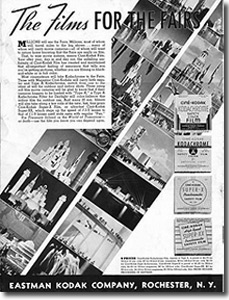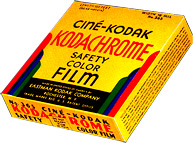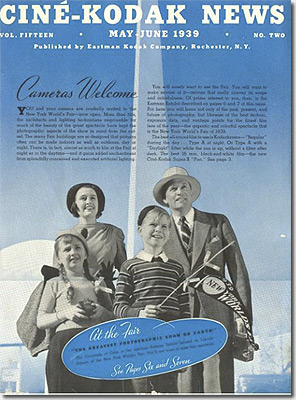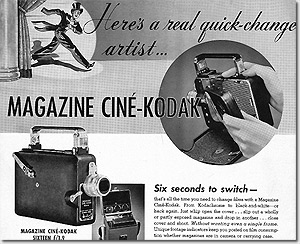Previous  1 2 3 4 5
1 2 3 4 5  Next
Next
"You and your camera are cordially invited to the New York World's Fair – now open." So began the lead article in the May-June 1939 issue of CINE-KODAK NEWS, a magazine for amateur moviemakers published by the Eastman Kodak Company.

The best all-around movie film to use at the Fair, according to Kodak, was Kodachrome, a color film available in two types: "Regular" for use in daylight, and "Type A" for use in artificial light. (Those moviemakers who followed this advice unwittingly bequeathed an invaluable inheritance to future generations. Unlike the dyes used in most other types of color film, those in Kodachrome do not fade over time. As a result, the colors in Kodachrome amateur movie footage of the Fair are still just as bright and fresh today as they were in 1939!)
As to the best movie camera to use, an article by a Mrs. Philip H. Thayer of New York City, which also appeared in the May-June issue of CINE-KODAK NEWS, mentioned the Magazine Cine-Kodak, a camera that used movie film preloaded into metal cartridges or "magazines." Using such a camera, a filmmaker could switch back and forth between Kodachrome "Regular" and Kodachrome "Type A" in a matter of seconds and without loosing a single frame of film. The Magazine Cine-Kodak also accepted a variety of different lenses, and had several different filming speeds, including one for capturing action in slow motion.

It should be pointed out that when the New York World's Fair took place, amateur movie making was primarily limited to those who were financially well-to-do. In 1939, a 16mm Magazine Cine-Kodak camera cost the equivalent of about $1800.00 in today's dollars. A metal magazine loaded with 50 feet of 16mm Kodachrome film cost the equivalent of $78. Furthermore, there was the additional expense of purchasing a movie projector, screen, extra camera lenses, and so on. However, and despite the economic hard times, by the late 1930s, amateur movie making had become a well-established and popular hobby. (When Kodak published HOW TO MAKE GOOD MOVIES in 1938, it quickly became a best-seller.)

The July-August 1939 issue of CINE-KODAK NEWS provided its readers with specific information for filming at the Fair based on "test shots" that had been taken there during its opening weeks. Amateur moviemakers were advised to "stop down" the apertures of their camera lenses an additional f-stop when shooting the bright buildings on sunny days. It was also recommended that they photograph the brilliant white buildings and statues with strong side lighting for contrast. According to Kodak, the inside of the Perisphere "is vast and dimly lighted" but could be filmed successfully using Kodak Super-XX black & white film at f/1.9. For making nighttime shots of the Fair's buildings, moviemakers should film at 8 frames per second (one half the normal amateur movie speed of 16 frames per second) when using Kodachrome Type A film.
One exception was the brightly lit Industrial Science Building, which could be filmed at regular speed. The electric arc in General Electric's Steinmetz Hall "is razor sharp in 'Type A' at f/8." General Motors' Futurama "is 'right' at f/1.9, regular speed, with Type A." When filming inside Futurama, filmmakers were advised to "Hold your camera high to avoid lens flare." Kodachrome Type A, when exposed at f1.9 at regular speed, was "entirely satisfactory for the brighter phases" of the Lagoon of Nations nighttime fountain show, and would capture the fireworks displays at f/3.5.

Subsequent issues of CINE-KODAK NEWS continued to encourage amateur movie making at the Fair by reproducing frame enlargements taken from movie film that had been shot at the Fair by other amateurs. (One wonders where all this footage is today!)
For those of us born too late to have experienced the 1939 New York World's Fair firsthand, it is the amateur Kodachrome movie footage that gives us the best idea of what it must have been like.
One of the best-known and extensive amateur film records of the Fair is the Medicus collection, containing literally hours of 16mm Kodachome movie footage, taken over a period of weeks or even months. Very little is known about the photographer other than that he lived in New York City, was financially well off, and traveled extensively. He was also a prominent amateur photographer and a noted collector of swords. More than likely, he used a Magazine Cine-Kodak camera, since several of his action scenes were filmed in slow motion.
Medicus' World's Fair films were later donated by his family to Rick Prelinger, whose Prelinger Archives now has them available as free, on-line downloads. If you're not familiar with this footage, by all means take the time to view it, since it will transport you back into time and allow you to see many of the same sights that visitors to the New York World's Fair saw in the long ago.
Previous  1 2 3 4 5
1 2 3 4 5  Next
Next
- Return to:
- Production & Distribution
